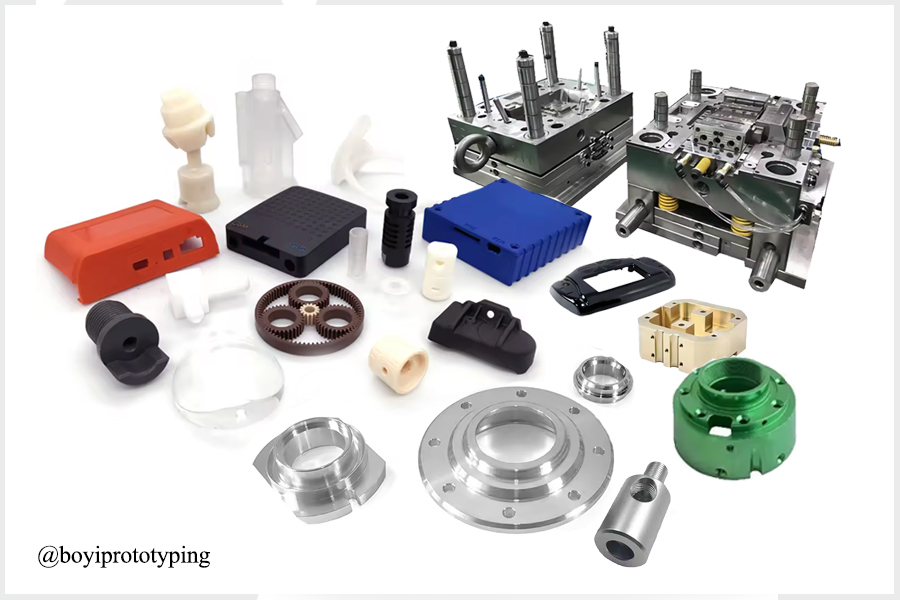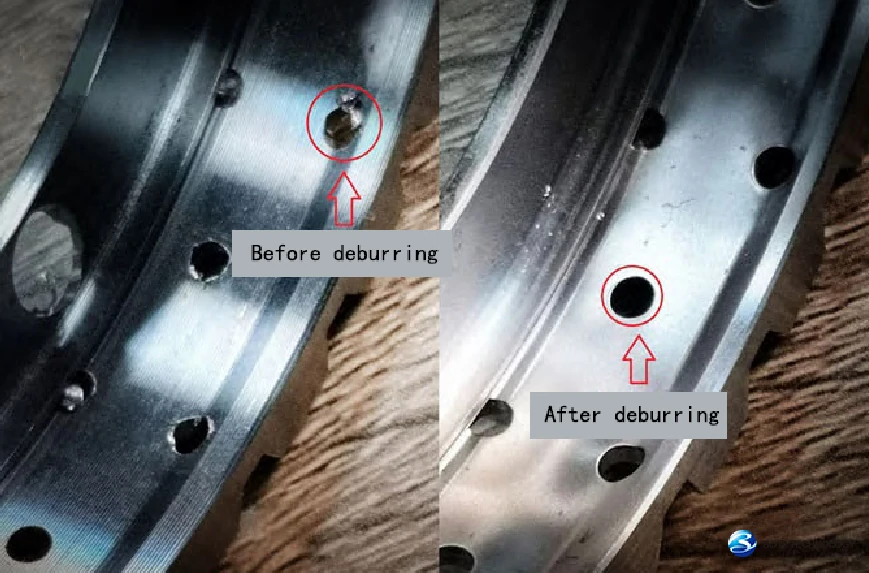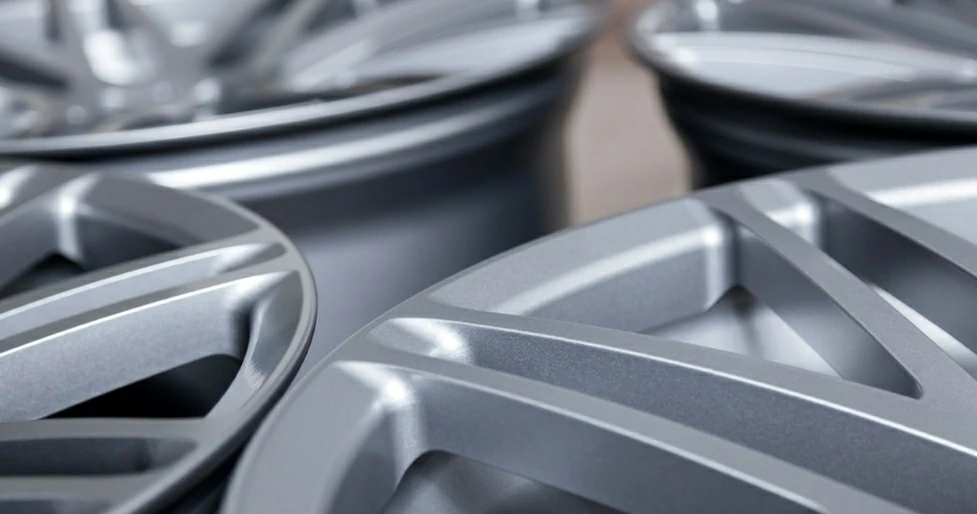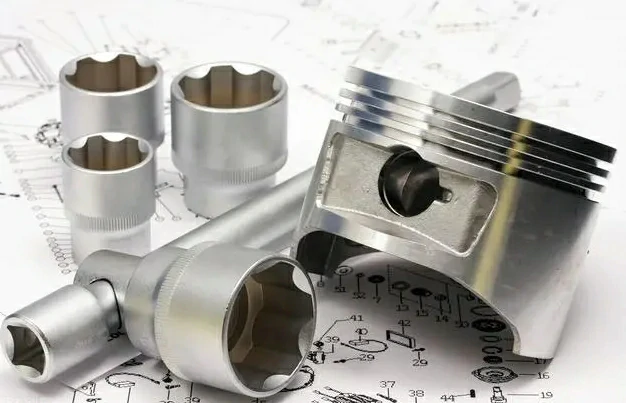Anodizing is an electrochemical process that enhances the natural oxide layer on the surface of metals, providing increased corrosion resistance, durability, and aesthetic appeal. While anodizing is commonly associated with aluminum, anodizing steel and stainless steel is also possible.
This article delves into the colors achievable through anodizing steel, the anodizing process itself, and a comparison with anodizing stainless steel.

What is Anodized Steel?
Anodized steel refers to steel that has undergone an electrochemical process called anodizing. This process enhances the surface properties of steel by forming a layer of oxide on its surface. The resulting oxide layer provides several benefits, including increased corrosion resistance, improved durability, and sometimes a decorative finish.
Anodizing Preconditions
Anodizing, traditionally associated with aluminum, has extended to metals such as steel, titanium and zinc, each requiring specific conditions for effective treatment. This chemical process involves complete immersion of the metal, necessitating design considerations for fixture support like hooks and chains to ensure uniform coating.
However, anodizing alters part dimensions and surface finishes, impacting dimensional accuracy and surface roughness. It also precludes the creation of thin, transparent coatings and entails substantial heating costs for maintaining process temperatures around 70°C in large tanks.
Process of Anodizing Steel
Anodizing steel involves several steps, which can be more complex than anodizing aluminum due to the different properties of the metals. Here is an overview of the process:
- Surface Preparation: The steel surface is thoroughly cleaned to remove any contaminants such as oils and grease. This step is crucial for ensuring a uniform and adherent oxide layer.
- Anodizing Bath: The cleaned steel is immersed in an electrolyte solution, typically containing acids such as sulfuric acid or chromic acid. An electric current is passed through the solution, causing oxygen ions to react with the steel surface. This reaction forms a layer of iron oxide (Fe2O3 or Fe3O4) on the steel.
- Dyeing (Optional): After anodizing, the steel can be dyed to achieve various colors. Dyes can penetrate the porous oxide layer and are sealed in place during subsequent processes.
- Sealing: The anodized steel is sealed to improve its corrosion resistance and color durability. This is usually done by boiling the steel in deionized water or steam to close the pores in the oxide layer.
Colors of Anodized Steel

Anodizing steel can produce a range of colors, though the palette is generally less extensive than that of anodized aluminum. Common colors for anodized steel include:
- Black: A popular color for its sleek, modern look and excellent wear resistance.
- Gray: Offers a subtle, industrial aesthetic.
- Bronze: Adds a warm, rich tone to the steel.
- Blue: Achievable through specific dye processes, though less common.
- Green: Similar to blue, it requires specific dyes and is less common.
The color range for anodized steel is somewhat limited due to the nature of the steel and the anodizing process, which doesn’t lend itself to the same vibrant hues as aluminum anodizing.
Applications of Anodized Steel
- Architectural Elements: Used in building facades, window frames, and other architectural applications due to its durability and aesthetic versatility.
- Automotive Parts: Anodized steel is employed in vehicle trim, grilles, and interior components where both durability and aesthetic appeal are essential.
- Decorative Items: It is popular for manufacturing furniture, household items, and decorative fixtures where a durable and visually appealing finish is desired.
Advantages of Anodized Steel
Anodized steel offers several advantages due to the protective oxide layer formed during the anodizing process. Here are the key advantages of anodized steel:
- Corrosion Resistance: Anodized steel exhibits enhanced resistance to corrosion compared to untreated steel. The oxide layer acts as a barrier, protecting the underlying steel from environmental factors such as moisture, humidity, and chemicals.
- Durability: The anodizing process hardens the surface of steel, making it more scratch-resistant and durable. This improves the lifespan of anodized steel products, reducing maintenance and replacement costs over time.
- Aesthetic Versatility: Anodized steel can be dyed to achieve various colors such as black, gray, bronze, and occasionally blue or green. This allows for customized aesthetics to match design preferences in architectural, automotive, and decorative applications.
- Improved Adhesion: The oxide layer formed during anodizing provides a better surface for paint adhesion, enhancing the durability and longevity of painted finishes on steel surfaces.
- Environmental Benefits: Anodizing is an environmentally friendly process compared to other surface finishing techniques. It does not involve heavy metals or produce harmful by-products, making it a sustainable choice for industries focused on reducing environmental impact.
- Temperature Resistance: Anodized steel can withstand a wide range of temperatures, making it suitable for applications exposed to varying environmental conditions, including outdoor and industrial settings.
- Electrical Insulation: The oxide layer on anodized steel provides electrical insulation properties, making it suitable for electrical enclosures and components where electrical conductivity needs to be controlled.
- Maintenance Ease: Anodized steel surfaces are easier to clean and maintain due to their smooth, non-porous finish. Routine cleaning with mild soap and water is typically sufficient to preserve its appearance and performance.
Anodized steel combines the inherent strength of steel with enhanced corrosion resistance, aesthetic appeal, and environmental benefits provided by the anodizing process. These advantages make it a preferred choice for applications requiring durable, attractive, and long-lasting metal finishes.
Disadvantage of Anodizing Steel
While anodizing steel offers various advantages, it also has some limitations and considerations that should be taken into account:
- Limited Color Options: Compared to anodized aluminum, the color options for anodized steel are more limited. Common colors include black, gray, bronze, and occasionally blue or green. Achieving vibrant or custom colors may be challenging due to the nature of steel and the anodizing process.
- Surface Preparation Requirements: Anodizing steel requires meticulous surface preparation to ensure the formation of a uniform and adherent oxide layer. This often involves thorough cleaning, degreasing, and sometimes mechanical or chemical pre-treatments, which can add complexity and cost to the process.
- Complex Anodizing Process: Anodizing steel is generally more complex than anodizing aluminum due to steel’s chemical properties. The process may involve different types of acids and electrolytes, as well as precise control over parameters such as temperature and current density.
- Potential for Surface Imperfections: Despite careful preparation, anodizing steel can sometimes result in surface imperfections such as streaking, uneven coloring, or uneven oxide layer thickness. These imperfections may affect the aesthetic appeal and performance of the finished product.
- Impact on Dimensions: The anodizing process can add a thin layer of oxide to the surface of steel, which may slightly alter dimensional tolerances. Manufacturers need to account for this dimensional change in precision applications.
Understanding these limitations allows for informed decision-making when considering anodized steel for specific applications. Despite these challenges, anodizing remains a valuable surface treatment for enhancing the durability, corrosion resistance, and aesthetic appeal of steel products in various industries.
The following is a simple comparison table of the advantages and disadvantages of anodized steel, which is convenient for everyone to make a detailed comparison:
| Advantages of Anodizing Steel | Disadvantage of Anodizing Steel |
|---|---|
| Protects steel from rust and corrosion. | Fewer color choices compared to anodized aluminum. |
| Hardens surface, increasing scratch resistance. | Requires meticulous cleaning and preparation. |
| Can be dyed to achieve various colors. | More intricate process compared to aluminum anodizing. |
| Enhances paint adhesion on the treated surface. | May result in streaking or uneven coloring. |
| Environmentally friendly process without heavy metals. | Can slightly alter dimensional tolerances. |
| Withstands a wide range of temperatures. | Generally higher cost due to process complexity. |
| Provides electrical insulation properties. | Difficulty achieving consistent vibrant colors. |
| Easy to clean and maintain. | Thinner layer may offer less protection in harsh environments. |
Anodizing Stainless Steel
Anodizing stainless steel differs from anodizing carbon steel and aluminum due to its unique properties. Stainless steel contains chromium, which forms a passive oxide layer naturally, making anodizing a more challenging process. The steps include:
- Surface Preparation: Similar to carbon steel, stainless steel requires thorough cleaning and degreasing. It may also involve mechanical or chemical pre-treatments to ensure a uniform surface.
- Electrolytic Coloring: Instead of forming a thick oxide layer, stainless steel undergoes a process called “electrolytic coloring” where the surface oxide layer is thickened and colored using a different electrolytic solution. This process produces colors through light interference effects, not dyes, leading to unique metallic hues.
- Sealing: The colored stainless steel is sealed to enhance its durability and corrosion resistance.
Anodized Steel vs. Anodized Stainless Steel
Anodized steel and anodized stainless steel differ in several key aspects, primarily due to their chemical compositions and properties:
| Feature/Property | Anodized Steel | Anodized Stainless Steel |
|---|---|---|
| Base Material | Carbon steel alloys | Stainless steel alloys |
| Oxide Layer Composition | Iron oxide (Fe2O3 or Fe3O4) | Chromium oxide (Cr2O3) |
| Corrosion Resistance | Moderate | High |
| Color Options | Limited (black, gray, bronze, etc.) | Limited (typically natural metallic hues) |
| Aesthetic Appeal | Customizable with dyes | Metallic, less vibrant |
| Applications | Architectural, automotive, decorative | High-end appliances, marine environments |
| Strength and Durability | Strong and durable | Stronger, more corrosion-resistant |
| Anodizing Process Complexity | Less complex | More complex |
| Cost | Generally lower | Higher due to material and process complexity |
| Galvanic Corrosion | More susceptible due to alloy composition | Less susceptible due to stainless steel properties |
| Surface Characteristics | Can affect machining finish and tolerances | Minimal impact on dimensions |
| Maintenance | Easy to clean and maintain | Requires minimal maintenance |
Summary:
- Anodized Steel: Suitable for applications where moderate corrosion resistance and customizable aesthetics are sufficient, but may require careful consideration of galvanic corrosion risks and maintenance needs.
- Anodized Stainless Steel: Preferred for environments demanding high corrosion resistance and durability, with less concern for galvanic corrosion. It is ideal for applications requiring a strong, low-maintenance material with a metallic finish.
Anodized Steel vs. Anodized Aluminum
Anodized steel and anodized aluminum differ significantly in their properties, manufacturing processes, and applications. Here are the key differences between anodized steel and anodized aluminum:
| Feature/Property | Anodized Steel | Anodized Aluminum |
|---|---|---|
| Base Material | Steel (iron, carbon, alloyed with metals) | Aluminum (aluminum, alloyed with magnesium, silicon) |
| Oxide Layer | Iron oxide (Fe2O3 or Fe3O4), less porous | Aluminum oxide (Al2O3), thick and porous |
| Anodizing Process | More complex, involving rigorous surface prep | Established process, electrolytic oxidation |
| Color Options | Limited (black, gray, bronze, some colors) | Extensive (natural metallic to vibrant dyes) |
| Applications | Architecture, automotive, decorative items | Aerospace, automotive, electronics, consumer goods |
| Strength and Weight | Strong, heavier | Strong, lightweight |
| Cost | Generally higher | More cost-effective |
While both anodized steel and anodized aluminum offer enhanced corrosion resistance, durability, and aesthetic appeal, they differ in composition, manufacturing processes, color options, and applications. Choosing between them depends on specific requirements such as strength, weight, color range, and economic considerations for the intended application.
Anodized Aluminum vs. Anodized Stainless Steel
Here’s a comparison table summarizing the differences between anodized aluminum and anodized stainless steel:
| Feature/Property | Anodized Aluminum | Anodized Stainless Steel |
|---|---|---|
| Base Material | Aluminum and its alloys | Stainless steel alloys |
| Oxide Layer Composition | Aluminum oxide (Al2O3) | Chromium oxide (Cr2O3) |
| Corrosion Resistance | High | Very high |
| Color Options | Extensive (vibrant colors possible) | Limited (typically natural metallic hues) |
| Aesthetic Appeal | Bright, vibrant colors | Metallic, less vibrant |
| Applications | Aerospace, automotive, consumer goods | High-end appliances, marine environments |
| Strength and Durability | Lightweight, strong | Stronger, more corrosion-resistant |
| Anodizing Process Complexity | Well-established, straightforward | More complex |
| Cost | Generally lower due to material availability | Higher due to material and process complexity |
| Galvanic Corrosion | Susceptible in mixed-metal applications | Less susceptible due to stainless steel properties |
Summary:
- Anodized Aluminum: Offers vibrant color options, high corrosion resistance, and is lightweight, making it suitable for aerospace, automotive, and consumer goods where aesthetics and durability are key.
- Anodized Stainless Steel: Provides superior corrosion resistance and strength, ideal for high-end appliances and marine environments where durability and a metallic finish are prioritized. It requires less concern for galvanic corrosion compared to mixed-metal applications with aluminum.
How to Anodize Aluminum?
Anodizing aluminum involves forming a protective oxide layer through electrochemical processes, enhancing corrosion resistance and providing a base for decorative finishes. Hardcoat anodizing further increases hardness up to 60-70 Rockwell C, making it highly abrasion-resistant. Stress relieving aluminum parts requires heating to 550-650°C and slow cooling to prevent internal stresses, crucial for maintaining dimensional stability in critical applications.
Can Stainless Steel Be Anodized?
Anodizing is primarily associated with aluminum and isn’t suitable for stainless steel due to its chemical properties. Unlike aluminum, which forms a protective oxide layer through anodizing, stainless steel develops a different type of oxide layer naturally that helps prevent corrosion. Anodizing steel can actually promote rust formation rather than preventing it.
To enhance the corrosion resistance of stainless steel, processes like plating or conversion coating are used instead. These methods involve applying a thin layer of another metal or a chemical treatment to the stainless steel surface. This layer acts as a barrier against corrosive elements, improving the steel’s durability and performance in harsh environments.
How Aluminum and Stainless Steel Corrode Differently?
Aluminum corrodes through oxidation, where its surface reacts with oxygen to form aluminum oxide. This oxide layer is typically thin and adherent, providing good corrosion resistance. However, if breached, aluminum can corrode more rapidly.
Stainless steel, on the other hand, contains chromium, which forms a passive oxide layer on the surface. This chromium oxide layer is more stable and protective than aluminum oxide, providing excellent corrosion resistance even in harsh environments. If the surface is damaged, the chromium in the alloy quickly reforms the protective oxide layer, maintaining the steel’s integrity.
Conclusion
Understanding the nuances of each process allows for informed decisions when selecting materials and finishes for specific applications. While anodized steel offers a range of colors and moderate protection, anodized stainless steel stands out for its superior corrosion resistance and unique metallic hues.
BOYI offers professional anodizing services to enhance the corrosion resistance and aesthetic appeal of your customized parts. Using advanced techniques, we meticulously treat each aluminum alloy component to create a durable and long-lasting oxide layer. Whether for protective or decorative purposes, BOYi’s anodizing services meet your diverse needs. Trust BOYI to deliver high-quality customized parts that provide lasting protection and superior appearance for your projects.

Let’s Start A New Project Today
Our engineers will contact you within 2 hours.
FAQ
Anodizing steel involves immersing it in an electrolytic bath to form an oxide layer. However, when combined with aluminum, this can lead to galvanic corrosion due to their different corrosion potentials. Stainless steel is preferred in such cases for better bonding with aluminum oxide layers, reducing galvanic corrosion risks and enhancing durability.
Anodizing is an electrochemical process that enhances the natural oxide layer on the surface of metals, particularly aluminum. This process increases the metal’s corrosion resistance, durability, and aesthetic appeal. During anodizing, the metal is immersed in an electrolyte bath and an electric current is passed through it. This causes oxygen ions to bond with the metal surface, forming a thicker, more protective oxide layer. Anodized surfaces can also be dyed in various colors, providing both functional and decorative benefits.
Anodizing comes in various types, each tailored for specific applications. Chromic acid anodizing (Type I) creates a thin, flexible oxide layer ideal for aerospace parts, while sulfuric acid anodizing (Type II) produces a thicker layer suitable for consumer products and architectural applications due to its good corrosion resistance and colorability. Hard anodizing (Type III) yields a very thick, wear-resistant layer, perfect for military and industrial uses.
Catalog: Surface Finishing Guide

This article was written by engineers from the BOYI team. Fuquan Chen is a professional engineer and technical expert with 20 years of experience in rapid prototyping, mold manufacturing, and plastic injection molding.




